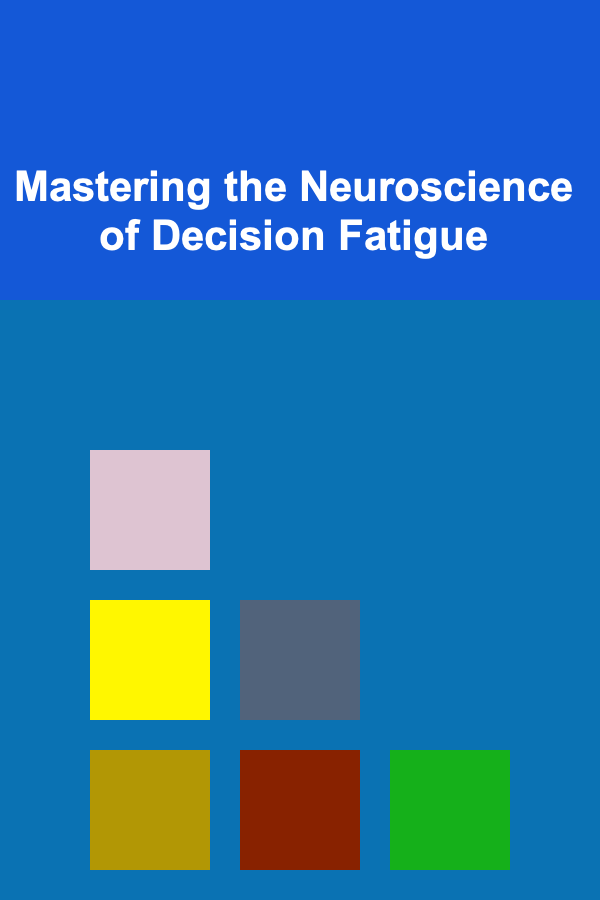
Mastering the Neuroscience of Decision Fatigue
ebook include PDF & Audio bundle (Micro Guide)
$12.99$6.99
Limited Time Offer! Order within the next:

Introduction: The Exhausting Reality of Choice
In today's hyper-connected and information-saturated world, we are constantly bombarded with choices. From the seemingly trivial -- what to wear, what to eat, which route to take to work -- to the significantly consequential -- investment strategies, career paths, and life partners -- decisions, decisions, everywhere. While the freedom to choose is often celebrated as a cornerstone of autonomy and progress, the relentless need to make decisions throughout the day can lead to a phenomenon known as decision fatigue. This isn't merely feeling tired; it's a state of depleted mental resources that significantly impairs our cognitive functions, affecting our judgment, willpower, and overall effectiveness. Understanding the neuroscience behind decision fatigue is crucial for mitigating its negative effects and optimizing our decision-making processes.
This article delves deep into the neuroscience of decision fatigue, exploring the brain regions involved, the neurochemical changes that occur, and practical strategies for managing and minimizing its impact. We will move beyond simple tips and tricks to provide a comprehensive, evidence-based understanding of how to protect your cognitive resources and make better decisions, even when faced with a demanding day.
The Neuroscience of Decision-Making: A Quick Overview
Before diving into decision fatigue, it's essential to understand the fundamental brain regions involved in decision-making:
- Prefrontal Cortex (PFC): The PFC, particularly the dorsolateral prefrontal cortex (DLPFC), is the command center for higher-level cognitive functions, including planning, working memory, and, most importantly, decision-making. It's responsible for evaluating options, weighing consequences, and inhibiting impulsive responses. The PFC allows us to consider long-term goals and override immediate gratification.
- Anterior Cingulate Cortex (ACC): The ACC plays a crucial role in conflict monitoring and error detection. It signals when a decision is difficult or when there is a conflict between different options. This signal then prompts the PFC to allocate more resources to resolve the conflict and make a choice.
- Amygdala: The amygdala is primarily associated with emotional processing, particularly fear and anxiety. It can influence decision-making by triggering emotional responses that bias our choices, especially in situations involving risk or uncertainty.
- Basal Ganglia: These structures are involved in habit formation and reward-based learning. They help us automate routine decisions and learn from past experiences to optimize future choices.
- Striatum: A key component of the basal ganglia, the striatum, especially the ventral striatum, is heavily involved in processing rewards and motivation. It helps us evaluate the potential value of different options and select the one that is most likely to lead to a positive outcome.
These brain regions work in concert to process information, evaluate options, and ultimately make decisions. Understanding their roles is crucial for grasping how decision fatigue impacts these processes.
Decision Fatigue: The Exhaustion of Cognitive Resources
Decision fatigue is the state of impaired decision-making quality that occurs after a prolonged period of making choices. It's not simply feeling tired or unmotivated; it's a measurable decline in cognitive performance across various domains. When we are constantly making decisions, the brain regions involved, particularly the PFC, become depleted of resources, leading to a range of negative consequences.
The Physiological Mechanisms
Research suggests that decision fatigue is associated with several physiological changes in the brain:
- Glucose Depletion: The PFC is a metabolically demanding region of the brain, requiring a significant amount of glucose to function optimally. Making decisions, especially difficult ones, consumes a considerable amount of glucose. As glucose levels decline, the PFC's ability to regulate behavior and make rational choices is compromised. This is supported by studies showing that replenishing glucose levels can temporarily reverse the effects of decision fatigue.
- Neurotransmitter Imbalances: Decision-making involves the release and reuptake of various neurotransmitters, including dopamine and serotonin. Prolonged decision-making can disrupt the balance of these neurotransmitters, affecting motivation, mood, and cognitive control. For example, depleted dopamine levels can lead to reduced motivation and increased impulsivity.
- Reduced Prefrontal Cortex Activity: Neuroimaging studies have shown that decision fatigue is associated with decreased activity in the PFC. This suggests that the PFC is less able to effectively monitor and regulate behavior when cognitive resources are depleted.
The Manifestations of Decision Fatigue
The effects of decision fatigue can manifest in a variety of ways, impacting both personal and professional life:
- Impaired Judgment: Decision fatigue can lead to poorer judgment and an increased susceptibility to biases and heuristics. We are more likely to make impulsive decisions, take unnecessary risks, or simply choose the easiest option without fully considering the consequences.
- Reduced Self-Control: Willpower is closely linked to decision-making. When decision fatigue sets in, our ability to resist temptations and stick to our goals is diminished. This can lead to overeating, procrastination, and other forms of self-sabotage.
- Increased Impulsivity: With a weakened PFC, we become more prone to impulsive behavior. We are less likely to think before we act and more likely to make rash decisions that we later regret.
- Avoidance of Decisions: Decision fatigue can lead to a desire to avoid making any more decisions. We may procrastinate on important tasks, delegate responsibilities, or simply defer decisions to a later time.
- Reduced Productivity: The cumulative effect of impaired judgment, reduced self-control, and increased impulsivity is a significant decline in productivity. We become less efficient, less focused, and less able to achieve our goals.
- Increased Irritability: Decision fatigue can also impact our emotional state, leading to increased irritability and frustration. We become more easily agitated and less tolerant of stress.
Strategies for Mastering Decision Fatigue: A Neuroscience-Informed Approach
Combating decision fatigue requires a multi-faceted approach that addresses the underlying neurological mechanisms and incorporates practical strategies for managing and minimizing its impact. Here are several evidence-based strategies:
1. Prioritize and Streamline Decisions
Not all decisions are created equal. Some decisions are more important than others and require more cognitive resources. By prioritizing and streamlining our decision-making processes, we can conserve our mental energy for the most critical tasks.
- Identify High-Impact Decisions: Determine which decisions have the greatest impact on your goals and priorities. Focus your energy on these decisions and delegate or automate the rest.
- Batch Similar Decisions: Group similar decisions together to minimize the cognitive switching costs. For example, instead of deciding what to wear each morning, plan your outfits for the entire week in advance.
- Establish Decision Criteria: Develop clear criteria for making routine decisions. This can help you avoid analysis paralysis and make choices more quickly and efficiently.
- Automate Routine Decisions: Automate as many routine decisions as possible. This could involve setting up automatic bill payments, using meal planning services, or creating standardized procedures for common tasks.
- Delegate Decisions: Don't be afraid to delegate decisions to others, especially if they have more expertise or time to dedicate to the task.
2. Implement a Structured Schedule and Time Management
A well-structured schedule can help you manage your cognitive resources more effectively by reducing the number of spontaneous decisions you need to make throughout the day.
- Plan Your Day in Advance: Create a detailed schedule for each day, allocating specific time slots for different tasks and activities. This can help you avoid decision fatigue by reducing the need to constantly decide what to do next.
- Schedule Decision-Making Time: Designate specific times of the day for making important decisions. Choose times when you are typically at your peak cognitive performance, such as in the morning after a good night's sleep.
- Use Time Blocking: Allocate specific blocks of time for focused work, free from distractions. This can help you conserve your cognitive resources and avoid decision fatigue by minimizing interruptions.
- Incorporate Breaks: Regular breaks are essential for replenishing cognitive resources. Short breaks throughout the day can help you stay focused and avoid burnout.
- Prioritize Sleep: Adequate sleep is crucial for optimal cognitive function. Aim for 7-9 hours of quality sleep each night to ensure that your brain is well-rested and prepared for the demands of the day.
3. Simplify Your Environment
Our environment can have a significant impact on our cognitive resources. A cluttered or overwhelming environment can increase decision fatigue by constantly demanding our attention and requiring us to make small, unnecessary choices.
- Declutter Your Workspace: Remove unnecessary items from your workspace to minimize distractions and reduce visual clutter.
- Organize Your Digital Environment: Organize your computer files, email inbox, and social media feeds to make it easier to find information and avoid feeling overwhelmed.
- Create a Designated Workspace: Designate a specific area for work that is free from distractions and conducive to focused attention.
- Minimize Sensory Overload: Reduce exposure to loud noises, bright lights, and other sensory stimuli that can drain your cognitive resources.
4. Optimize Your Diet and Lifestyle
Diet and lifestyle play a crucial role in maintaining optimal cognitive function and mitigating the effects of decision fatigue.
- Maintain Stable Blood Sugar Levels: Fluctuations in blood sugar levels can impair cognitive function and exacerbate decision fatigue. Eat regular meals and snacks throughout the day to maintain stable blood sugar levels. Focus on complex carbohydrates, lean proteins, and healthy fats.
- Stay Hydrated: Dehydration can impair cognitive function and increase feelings of fatigue. Drink plenty of water throughout the day to stay hydrated.
- Limit Processed Foods and Sugar: Processed foods and sugary drinks can cause blood sugar spikes and crashes, leading to impaired cognitive function and increased decision fatigue.
- Consume Brain-Boosting Nutrients: Incorporate foods rich in brain-boosting nutrients, such as omega-3 fatty acids (found in fatty fish, flaxseeds, and walnuts), antioxidants (found in fruits and vegetables), and choline (found in eggs and liver).
- Practice Mindfulness and Meditation: Mindfulness and meditation can help you reduce stress, improve focus, and enhance cognitive control. Regular practice can strengthen the PFC and make you more resilient to decision fatigue.
- Engage in Regular Exercise: Exercise has been shown to improve cognitive function, reduce stress, and enhance mood. Aim for at least 30 minutes of moderate-intensity exercise most days of the week.
5. Implement Decision-Making Frameworks and Heuristics
Decision-making frameworks and heuristics can help you simplify complex decisions and make choices more quickly and efficiently.
- Use a Decision Matrix: A decision matrix is a tool that allows you to systematically evaluate different options based on a set of criteria. This can help you make more informed decisions and avoid emotional biases.
- Apply the 80/20 Rule: The Pareto principle, also known as the 80/20 rule, states that 80% of the results come from 20% of the effort. Focus your energy on the 20% of tasks that will have the greatest impact and delegate or eliminate the rest.
- Use Occam's Razor: Occam's razor is a problem-solving principle that states that the simplest explanation is usually the best. When faced with a complex decision, try to identify the simplest solution that will achieve your desired outcome.
- Consider the "Regret Minimization Framework": When facing a difficult decision, ask yourself which option you are least likely to regret in the future. This can help you make choices that are aligned with your values and long-term goals.
6. Cultivate Self-Awareness and Monitor Your Cognitive State
Self-awareness is crucial for managing decision fatigue. By becoming more attuned to your cognitive state, you can recognize when you are starting to experience decision fatigue and take steps to mitigate its effects.
- Track Your Energy Levels: Pay attention to your energy levels throughout the day and identify the times when you are most likely to experience decision fatigue.
- Monitor Your Decision-Making Quality: Regularly assess the quality of your decisions and identify any patterns or biases that may be affecting your choices.
- Use a Decision Journal: Keep a journal to track the decisions you make each day, the factors that influenced your choices, and the outcomes that resulted. This can help you identify areas where you can improve your decision-making processes.
- Practice Self-Compassion: Be kind to yourself when you make mistakes or experience decision fatigue. Remember that everyone makes poor decisions from time to time, and that it's important to learn from your mistakes and move on.
The Future of Decision Fatigue Research
The field of decision fatigue research is still evolving, and there are many unanswered questions about the underlying neurological mechanisms and the most effective strategies for mitigating its impact. Future research is likely to focus on the following areas:
- Identifying the Specific Neurotransmitters and Brain Regions Involved: More research is needed to pinpoint the exact neurotransmitters and brain regions that are most affected by decision fatigue. This could lead to the development of targeted interventions that can help restore cognitive function.
- Developing More Accurate Measures of Decision Fatigue: Current measures of decision fatigue are often subjective and lack precision. Future research should focus on developing more objective and reliable measures that can be used to assess the severity of decision fatigue.
- Investigating the Long-Term Effects of Decision Fatigue: Little is known about the long-term effects of chronic decision fatigue. Future research should examine whether chronic decision fatigue can lead to long-term cognitive decline or other health problems.
- Exploring the Role of Individual Differences: People vary in their susceptibility to decision fatigue. Future research should explore the factors that contribute to these individual differences, such as genetics, personality traits, and lifestyle habits.
- Developing Personalized Interventions: The most effective strategies for mitigating decision fatigue may vary depending on the individual. Future research should focus on developing personalized interventions that are tailored to the specific needs and preferences of each individual.
Conclusion: Empowering Your Decision-Making
Decision fatigue is a real and significant threat to our cognitive resources and overall well-being. By understanding the neuroscience behind this phenomenon and implementing the strategies outlined in this article, you can take control of your decision-making processes, protect your cognitive resources, and make better choices, even when faced with a demanding day. Mastering the neuroscience of decision fatigue is not just about improving productivity; it's about empowering yourself to live a more fulfilling and effective life.
Remember that managing decision fatigue is an ongoing process. It requires consistent effort and a willingness to adapt your strategies as needed. By cultivating self-awareness, prioritizing your decisions, simplifying your environment, and optimizing your diet and lifestyle, you can build resilience to decision fatigue and unlock your full cognitive potential.
Reading More From Our Other Websites
- [Home Renovating 101] How to Waterproof Your Basement: A Step-by-Step Guide
- [Home Renovating 101] How to Build and Renovate a Deck: Step-by-Step Guide
- [Personal Care Tips 101] How to Use Hair Serum to Maintain Healthy Hair During Winter
- [Home Renovating 101] How to Transform Your Garage Renovation Projects into Extra Living Space
- [Home Holiday Decoration 101] How to Style Your Christmas House Window Decorations
- [Home Staging 101] How to Style and Arrange Furniture to Make a Small Room Look Bigger in Your Listing Photos
- [Polymer Clay Modeling Tip 101] How to Build a Portable Polymer Clay Studio for On‑The‑Go Artists
- [Organization Tip 101] What Techniques Can Help You Organize Your Workspace at Home?
- [Skydiving Tip 101] The Science Behind Freefall: How Altitude Impacts Speed and Duration
- [Metal Stamping Tip 101] Choosing the Right Deburring Method for Different Metals and Stamping Applications

10 Essential Skills Employers Look for in Candidates
Read More
How to Manage Your Online Subscriptions Efficiently
Read More
How to Safely Introduce Your Pet to New Home Renovations
Read More
How to Utilize Nooks and Crannies for Additional Storage
Read More
How To Improve Your Luck Management in Board Games
Read More
10 Tips for a Comprehensive Marketing Project Management Checklist
Read MoreOther Products

10 Essential Skills Employers Look for in Candidates
Read More
How to Manage Your Online Subscriptions Efficiently
Read More
How to Safely Introduce Your Pet to New Home Renovations
Read More
How to Utilize Nooks and Crannies for Additional Storage
Read More
How To Improve Your Luck Management in Board Games
Read More